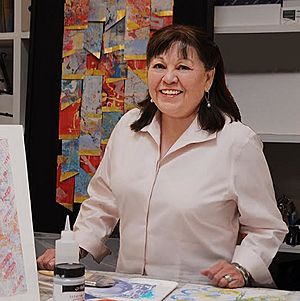Ramona Sakiestewa facts for kids
Quick facts for kids
Ramona Lynn Sakiestewa
|
|
|---|---|

Sakiestewa in 2015
|
|
| Born | 1948 (age 76–77) Albuquerque, New Mexico, U.S.
|
| Nationality | American, Hopi |
| Education | School of Visual Arts |
| Known for | Tapestries |
Ramona Sakiestewa (born 1948) is a famous Hopi Native American artist. She lives and works in Santa Fe, New Mexico. Ramona Sakiestewa is well-known for her beautiful tapestries, art on paper, and large art pieces in public buildings.
Contents
Early Life and Learning
Ramona Sakiestewa was born in Albuquerque, New Mexico. Her father was Hopi, and her mother had German, English, and Irish family. She went to school in Arizona and Santa Fe.
To learn more about design and colors, Ramona traveled to New York City in the late 1960s. She studied at the School of Visual Arts. After her studies, she came back to the Southwest. She worked at the Museum of New Mexico in Santa Fe, helping to manage art projects.
Ramona's Art Career
Becoming a Weaver
Ramona Sakiestewa taught herself how to weave. She used old weaving methods from the Pueblo people of the American Southwest. In her early work, she used yarn that she spun and dyed herself. She studied how Native Americans used plants to make dyes. She also learned how to use special dyes like cochineal (red) and indigo (blue).
Ramona changed old weaving methods to work on a modern floor loom. In 1981, she opened her own weaving studio called Ramona Sakiestewa Ltd. She started making unique tapestries full-time.
Her first weavings were simple rugs with stripes. They were in the classic Pueblo style but with new colors. She learned by reading books and getting help from friends. She became very good at dyeing yarn. Soon, she started showing her art at the Santa Fe Indian Market. Ramona often made tapestries that were about 50 by 70 inches. Her art is usually abstract, meaning it uses shapes and colors to show ideas. She says this style helps her capture the feeling of things. These things could be old traditions, ceremonies, or the beautiful landscape of the Southwest.
"(Sakiestewa) has pressed issues of scale, texture, color and tone in works that shatter old barriers separating weaving, painting and mixed media." - Ann Lane Hedlund
In the late 1980s, Ramona wove thirteen tapestries. These were based on drawings by the famous architect Frank Lloyd Wright. She also made six tapestries for Gloria Frankenthaler Ross. These were based on paintings by the artist Kenneth Noland. Ramona was also asked to design special blankets. These were made by Pendleton Blankets and Scalamandre.
Designing for Buildings
In 1994, Ramona Sakiestewa was invited to help design the National Museum of the American Indian. This museum is part of the Smithsonian in Washington, D.C. It was a big project that took 10 years. Ramona helped create the design style for the museum. She worked with others to design many parts of the building. This included the main entry doors and a large copper screen wall. She also designed a huge theater curtain and other parts inside the museum. The museum opened on September 21, 2004. Ramona also wrote an essay called "Making Our World Understandable" for a book about the museum.
In 2009, Ramona closed her weaving studio. She wanted to focus more on her art on paper, paintings, and architectural projects. She continued to work with architects on other buildings. These included the Tempe Center for the Performing Arts in Arizona and the Chickasaw Cultural Center in Oklahoma. She also worked on the Komatke Health Center in Arizona.
Because of her experience with public art and Native American culture, Ramona is often asked for advice. She helps with cultural projects in the U.S. and other countries. She also worked as a design helper for an observatory at the University of New Mexico.
Helping the Arts Community
In 1980, Ramona Sakiestewa became the first Native American woman to lead the Southwestern Association for Indian Arts (SWAIA). This group puts on the yearly Santa Fe Indian Market.
Ramona has also served on many important boards. She was the chair of the New Mexico Arts Commission. She was also a trustee for the International Folk Art Foundation in Santa Fe. She helped advise the National Park Service. She was also a trustee for the Georgia O'Keeffe Museum in Santa Fe.
Awards and Recognition
Ramona Sakiestewa has won many awards for her art. Some of these include:
- The New Mexico Governor's Award for Excellence in the Arts (2006)
- The Governor's Outstanding New Mexico Woman's Award (2006)
- Being added to the New Mexico Women's Hall of Fame (2006)
- An award from the New Mexico Committee of the National Museum of Women in the Arts (2007)
- Being chosen as an artist for "Gift to the Nation" in Washington D.C. (2001)
She also won many awards for her weaving at the Santa Fe Indian Market from 1982 to 1991.
Personal Life
In 1978, Ramona married the poet Arthur Sze. They have one son named Micah. In 1998, Ramona married Andrew F. Merriell, who is an architect and exhibit designer.
Where to See Her Art
Ramona Sakiestewa's art is in many museums. Some of these include:
- National Museum of American History, Washington, D.C.
- New Mexico Museum of Art, Santa Fe, NM
- Heard Museum, Phoenix, AZ
- Saint Louis Art Museum, St. Louis, MO
- Denver Art Museum, Denver, CO
- Mint Museum of Craft + Design, Charlotte, NC
- Albuquerque Museum of Art and History, Albuquerque, NM
- Wheelwright Museum of the American Indian, Santa Fe, NM
- University of Pennsylvania Museum of Archaeology and Anthropology, Philadelphia, PA
Her work was also part of a special exhibition called "Hearts of our People: Native Women Artists" at the Minneapolis Institute of Art.

